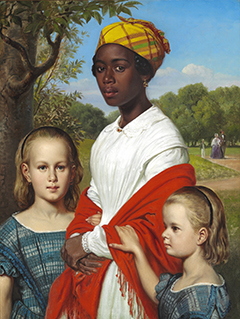Marstrand’s Unusual Family Portrait
This year, it is 100 years since Denmark’s national flag flew over the Danish West Indies for the last time before we sold the three Caribbean islands of St. Thomas, St. Croix and St. John to the United States for 25 million Dollars. We had owned the islands since 1672 and up until 1917 many Danes journeyed to the Danish West Indies to work as civil servants, priests, teachers and more. This was also the case for the Danish Golden Age painter Wilhelm Marstrand’s brother Otto Marstrand. In 1830, he settled down on St. Thomas as a timber merchant, raised a family and was later appointed Consul and Chief Fire Officer. In 1857 the whole Caribbean branch of the Marstrand family visited Denmark, and they brought their Afro-Caribbean nanny Justina with them. It was during a walk in the Frederiksberg Gardens that the family was immortalized in the painting up for auction.
An Afro-Caribbean Nanny at the Centre of the Painting
As the dominant figure of the painting, Justina gazes at the viewer with a serious look in her eyes. She is dressed in a European, white dress and a red shawl, while she is wearing a traditional Afro-Caribbean, orange and green headdress. The colourful dress stands in contrast to the blue summer sky and the lush Danish nature. The painting’s composition is structured around the beautiful nanny Justina with the two Marstrand girls, Emily Ottilie and Annie Lætitia, on each side. In the background, Otto Marstrand, the wife Annie and their son Osvald are strolling in the park, and unlike the figures in the foreground they are depicted more sketch-like and with much less attention to detail. Why Justina constitutes such a central part of the painting is open to interpretation, but the portrait provides an important and rare artistic insight into Denmark's role as a colonial power and slave nation.
Important Danish Cultural History
The painting was made nine years after the abolishment of slavery in the Danish West Indies, and it is therefore most likely that the young nanny was born a slave. In Denmark, we have relatively few paintings that depict the Danes and their relationship with the slaves and their descendants on the Danish West Indies, and it is therefore a rarity to see this kind of painting on the auction market. The painting has never been up for auction before, since it has been passed down through Otto Marstrand’s family. The daughter Emily, depicted on the right in the painting’s foreground, inherited it after her father. Afterwards, her daughter Edna inherited the painting, and she is the current owner’s grandmother.
Auction: Tuesday, 30 May at 4 pm in Bredgade 33, Copenhagen
Preview: 24-29 May at the same address
View all the fine art up for auction
View all the lots of the auction
Read more about the auction
Read more about how to bid
For further information, please contact:
Julie Arendse Voss: +45 8818 1123 · jav@bruun-rasmussen.dk
Birte Stokholm: +45 8818 1122 · bst@bruun-rasmussen.dk
